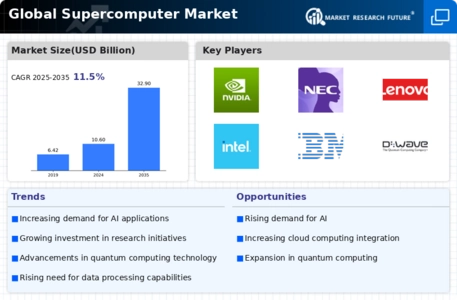Market Analysis
In-depth Analysis of Supercomputer Market Industry Landscape
The market dynamics of the Supercomputer market are shaped by a variety of factors that collectively influence its growth, trends, and competitive landscape. Technological advancements serve as a driving force, with continuous innovation playing a pivotal role in shaping the market dynamics. The introduction of cutting-edge technologies, such as quantum computing and advanced parallel processing, significantly impacts the market by enhancing computing capabilities and opening up new possibilities for applications.
Market demand is a key dynamic, influenced by the increasing reliance on supercomputing solutions across various industries. Sectors like healthcare, finance, weather forecasting, and artificial intelligence continually drive the need for more powerful computing resources. As these industries grow, the demand for supercomputers follows suit, creating a dynamic market environment where evolving requirements fuel innovation and competition among manufacturers.
The global economic landscape plays a crucial role in the dynamics of the Supercomputer market. Economic conditions influence the purchasing power of businesses and institutions, impacting their ability to invest in high-performance computing solutions. Additionally, government budgets allocated for research and development projects contribute significantly to the market's growth, as public institutions often rely on supercomputing resources for scientific research, national security, and various other applications.
Competition is inherent in the market dynamics, with major players constantly striving to outperform each other. This competitive landscape fosters innovation as companies invest in research and development to introduce faster, more energy-efficient, and cost-effective solutions. Mergers and acquisitions are common strategies to strengthen market positions and expand product portfolios, adding an additional layer of dynamism to the industry.
Geopolitical factors also contribute to the dynamic nature of the Supercomputer market. Trade tensions, political instability, and international collaborations can impact the market by influencing the flow of technology components, manufacturing processes, and distribution channels. Tariffs and export restrictions may disrupt the supply chain, leading to price fluctuations and availability issues.
Environmental considerations are increasingly shaping market dynamics. With a growing emphasis on sustainability, manufacturers are investing in research to develop energy-efficient supercomputing solutions. This focus on environmental responsibility not only addresses concerns about the ecological impact of high-performance computing but also aligns with the broader trend of businesses adopting greener practices.
Regulatory factors also play a role in shaping the market dynamics. Compliance with industry standards and regulations, especially in sectors like healthcare and finance, is crucial for supercomputer manufacturers. Adherence to data protection and privacy regulations is essential as these systems often handle sensitive information. Changes in regulations can impact product development, marketing strategies, and overall market dynamics.
The rate of technological adoption and acceptance is a critical dynamic in the Supercomputer market. As organizations become more comfortable with integrating supercomputing into their operations, the market experiences increased demand. Education and awareness programs about the benefits and applications of supercomputers are essential to accelerate this adoption process and influence market dynamics positively.















Leave a Comment